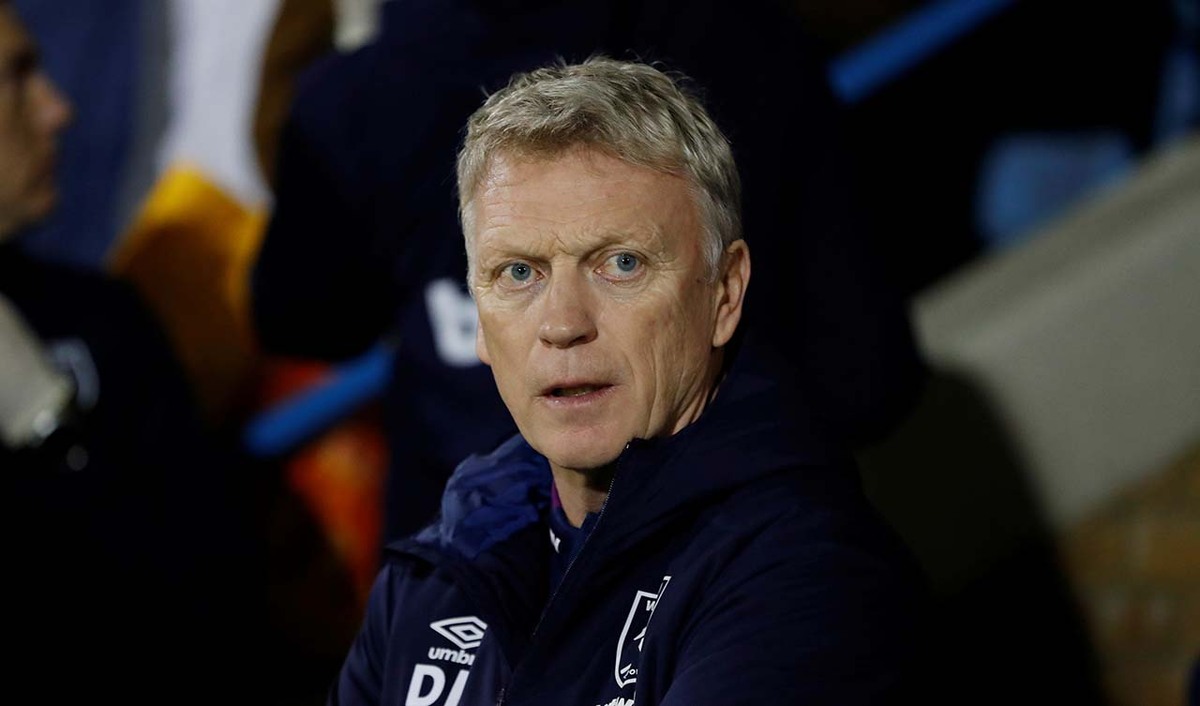




OUR BEST EVER OFFER - SAVE £100/$100
JOIN THE WORLD'S LEADING PROFESSIONAL DEVELOPMENT PROGRAMME
- 12 months membership of Elite Soccer
- Print copy of Elite Player & Coach Development
- Print copy of The Training Ground
Defending against a switch of play
This session is designed to work on a team’s defensive balance, shape and its covering positions when defending against switches of play.
| Area | Half a full size pitch |
| Equipment | Balls, bibs, 4 full size goals, 2 target goal |
| No. of Players | 20 players + 4 goalkeepers |
| Session Time | Main session: 20mins, Progression 1: 25mins, Progression 2: 15mins |
This session is designed to work on a team’s defensive balance, shape and its covering positions when defending against switches of play.
Attacking play looks to exploit space and players will find opportunities to switch the ball and score in a goal that the defending team has failed to cover and protect. This session will encourage your defensive players to guard against that happening.
We would normally use this session when we are on a ‘working day’ – when we want to achieve specific physical outputs, as well as technical and tactical. Due to the size of the area used it needs quick play, both offensively and defensively, meaning players work at a high intensity throughout. We are looking for a high number of accelerations and decelerations rather than distance covered.
What do I get the players to do?
Use half your pitch with two full size goals either side of a target goal at one end, as shown [1a/1b].
Divide your squad into two teams of 10, one which will attack (the blues) and one to defend (the reds).
Position one goalkeeper in each of the large goals and use the two remaining keepers as servers.
Line up the two teams as you normally would.
1a
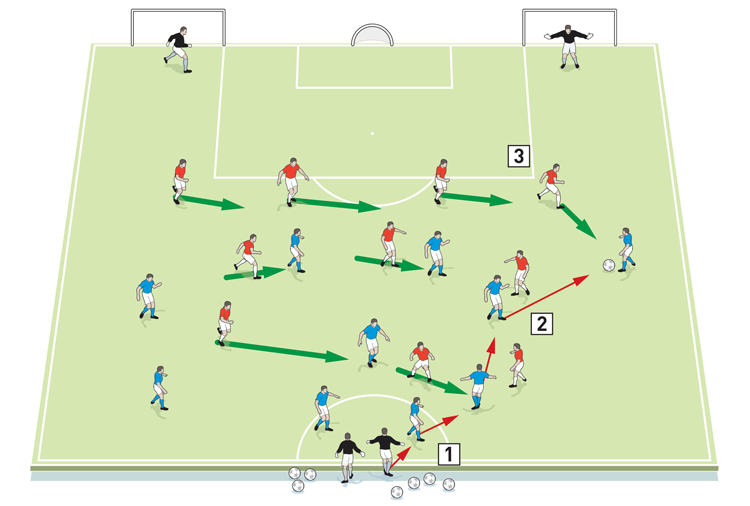
2. Play goes live as soon as the attacking team receives the ball. They must build up play to attack any of the three goals
3. Here the ball moves down the defending team’s left flank so one defender goes to the ball and the other three move across to cover the two goals nearest the ball, leaving space on the far side
1b
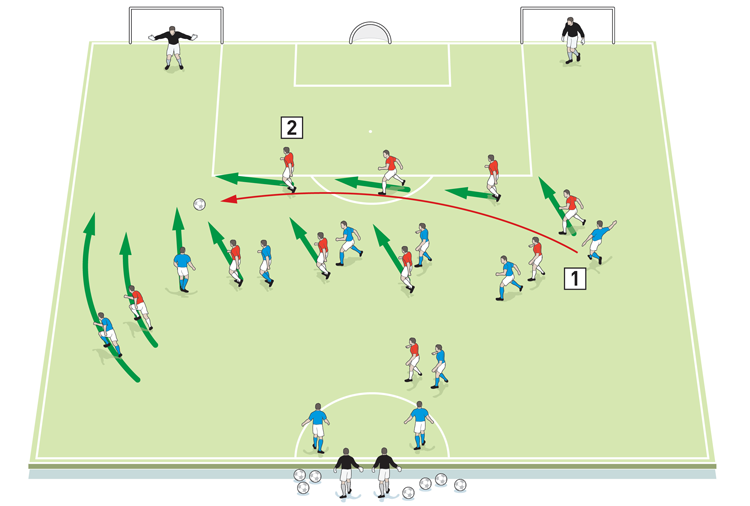
2. Now defenders must react to the switch and move to block and cover
3. Quick reactions are key for the defending team. They must get across as a unit or one of them must go 1v1 to delay the attack
The game starts at the end opposite to the goals, with one server playing a ball out to a member of the attacking team.
As soon as the attacking team receives the ball, play goes live, and they must build up play to attack any of the three goals. The defending team must attempt to stop them scoring, and if they gain possession the defenders must try to run the ball over the halfway line to score.
When defending, make sure that your players do not switch off – they must be constantly communicating with one another to protect the two goals. As the attacking team looks to switch the ball to find scoring opportunities in either goal, that results in lots of 1v1 and 2v2 situations and opens up attacking possibilities.
We find the intensity of this practice is very high so when defending, your players need to be fully focused and determined not to concede.
How do I progress the session?
After both teams have worked at both the defending and attacking phase of the initial practice, we would progress the same situation by adding goals at the other end.
Both teams now have to defend two large goals and a central target goal, as shown [2]. Each team now has two goalkeepers, one protecting each of the two large goals.
2
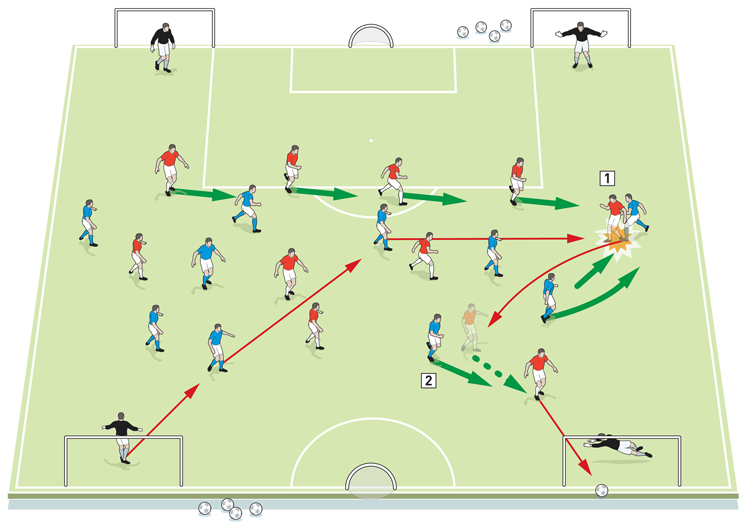
2. Look for players reacting to the position of the ball and the goal that is in danger of being attacked. Here the blue defenders aren’t compact enough or quick enough to prevent a goal
For the final progression, use the same set-up but split the pitch down the centre with cones,creating a central line as shown [3]. Now the ball has to be transferred over the central line at least once before the attackers attempt to score, forcing them to switch the play.
3
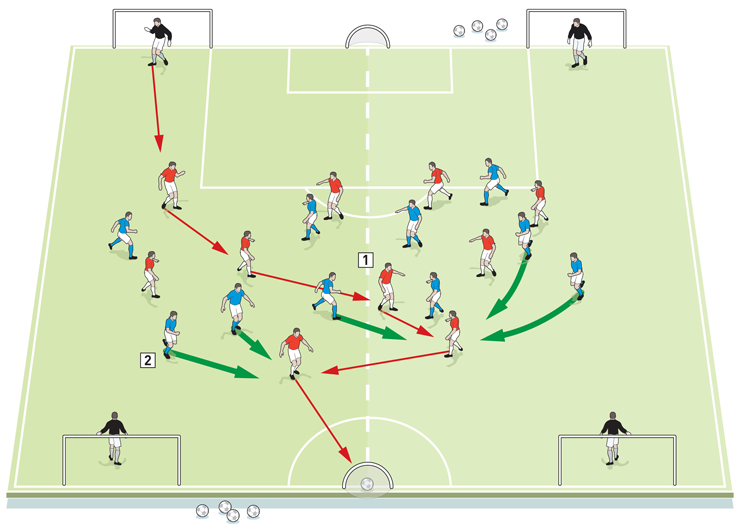
2. The blue defenders have blocked the route to both of the full size goals but have neglected cover the small target goal, leaving the attacker free to score
What are the key things to look out for?
Tactically it is vital that the defending units set across the pitch with little spaces between them to protect the goal that is being attacked. Can they be compact if they have enough players or does it require 1v1 defending to delay the attack?
To score, the attacking team needs to move the ball quickly to find gaps and exploit the space on the other side of the pitch.
What are the typical mistakes that players might make?
Teams fail to recognise the importance of protecting the central target goal. It is there to make the practice more real and stop the defending team from just protecting the wide goals and splitting their back line with a big space centrally.
Related Files
Editor's Picks
Attacking transitions
Deep runs in the final third
Using the goalkeeper in build-up play
Intensive boxes drill with goals
Penetrating the final third
Creating and finishing
My philosophy
Pressing initiation
Compact team movement
Coaches' Testimonials

Alan Pardew

Arsène Wenger

Brendan Rodgers

Carlos Carvalhal

José Mourinho

Jürgen Klopp

Pep Guardiola

Roy Hodgson

Sir Alex Ferguson

Steven Gerrard
Related
Coaches' Testimonials

Gerald Kearney, Downtown Las Vegas Soccer Club

Paul Butler, Florida, USA

Rick Shields, Springboro, USA

Tony Green, Pierrefonds Titans, Quebec, Canada
Join the world's leading coaches and managers and discover for yourself one of the best kept secrets in coaching. No other training tool on the planet is written or read by the calibre of names you’ll find in Elite Soccer.
In a recent survey 92% of subscribers said Elite Soccer makes them more confident, 89% said it makes them a more effective coach and 91% said it makes them more inspired.
Get Monthly Inspiration
All the latest techniques and approaches
Since 2010 Elite Soccer has given subscribers exclusive insight into the training ground practices of the world’s best coaches. Published in partnership with the League Managers Association we have unparalleled access to the leading lights in the English leagues, as well as a host of international managers.
Elite Soccer exclusively features sessions written by the coaches themselves. There are no observed sessions and no sessions “in the style of”, just first-hand advice delivered direct to you from the coach.
